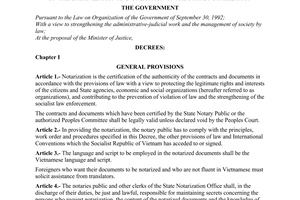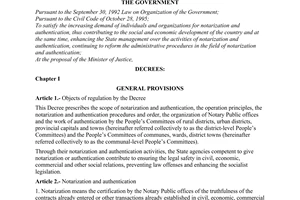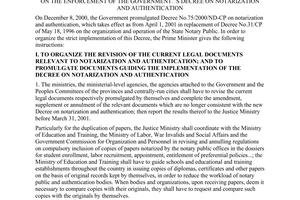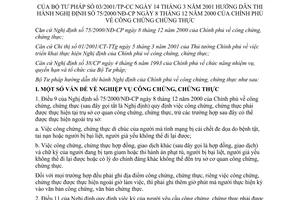Nội dung toàn văn Circular No.03/2001/TP-CC, promulgated by the Ministry of Justice, guiding the implementation of the Government’s Decree No.75/2000/ND-CP of December 8, 2000 on notarization and authentication.
|
THE
MINISTRY OF JUSTICE |
SOCIALIST REPUBLIC OF VIET NAM |
|
No: 03/2001/TP-CC |
Hanoi, March 14, 2001 |
CIRCULAR
GUIDING THE IMPLEMENTATION OF THE GOVERNMENT’S DECREE NO. 75/2000/ND-CP OF DECEMBER 8, 2000 ON NOTARIZATION AND AUTHENTICATION
Pursuant to the Government’s Decree No.
75/2000/ND-CP of December 8, 2000 on notarization and authentication;
Pursuant to the Prime Minister’s Directive No. 01/2001/CT-TTg of March 5, 2001
on the implementation of the Government’s Decree on notarization and
authentication;
Pursuant to the Government’s Decree No. 38/CP of June 4, 1993 on the functions,
tasks, powers and organizational structure of the Justice Ministry;
The Justice Ministry hereby guides the implementation of the Government’s
Decree on notarization and authentication as follows:
I. A NUMBER OF ISSUES REGARDING NOTARIZATION AND AUTHENTICATION OPERATIONS
1. Article 9 of the Government’s Decree No. 75/2000/ND-CP of December 8, 2000 on notarization and authentication (hereafter referred to as the Decree for short) prescribes that the notarization or authentication must be performed at the notarization or authentication agencies’ offices, except for the following cases which may be performed outside the offices:
a/ The notarization or authentication of testaments of persons whose lives are threatened by illness and/or accidents, or who are paralytic, or aged and weak persons who are unable to move on their own;
b/ The notarization or authentication of contracts, other transactions (hereafter referred to as contracts or transactions) and signatures of persons who are being detained or serving imprisonment sentences, paralytics, aged and weak persons who are unable to move on their own or those who, for plausible reasons, cannot go to the notarization or authentication agencies’ offices.
For all cases, the places of notarization or authentication must be inscribed. Particularly for notarization or authentication operations performed beyond the working hours, the hours and minutes when the notarization or authentication performers sign on the notarized or authenticated documents must also be inscribed.
2. Article 11 of the Decree prescribes that the notarization or authentication requesters’ signing must be made in front of the notarization or authentication performers. In cases where credit institutions’ or enterprises’ persons competent to sign contracts have registered their specimen signatures at the notarization or authentication agencies, such persons may be allowed to put their signatures on contracts in advance. The notarization or authentication performers shall compare their signatures on the contracts with the specimen signatures, before performing the notarization or authentication.
3. The fingerprint pressing shall be made instead of the signing on papers requested to be notarized or authenticated if the notarization or authentication requesters are unable to sign due to their physical defects or simply because that they do not know how to sign.
The fingerprint pressing may also be made simultaneously with the signing in the following cases:
a/ Notarization or authentication of testaments;
b/ At the requests of notarization or authentication requesters;
c/ At the requests of notarization or authentication performers, after they examine the presented papers and deem that the notarization or authentication requesters’ identification is unclear; the notarization or authentication requesters rarely give their signatures or it is deemed necessary to protect the notarization or authentication requesters’ interests.
When pressing fingerprints, the notarization or authentication requesters shall use their right index fingers. If the fingerprint pressing cannot be made with right index fingers, the left ones shall be used; where the fingerprint pressing cannot made by the index fingers, it shall be made by the other fingers. After the fingerprint pressing is made, it must be clearly inscribed that which finger of which hand is used therefor.
The above guidance shall also apply to the fingerprint pressing by witnesses.
4. In case of refusal to effect the notarization or authentication according to the provisions of Clause 5, Article 38 of the Decree, the notarization or authentication performers shall have to clearly explain in writing reason(s) for the refusal, if so requested by the notarization or authentication requesters.
5. Regarding the undertaking to keep testaments as prescribed in Article 51 of the Decree, the notaries shall have to seal the testaments, then the testators shall sign or press fingerprints thereon, and the notaries shall sign and affix stamps on gluing seams of envelopes containing such testaments. When undertaking to keep a testament, the notary must make a testament-keeping undertaking paper in two copies, one shall be handed to the testator and the other kept at the notary public office.
The testament-keeping undertaking paper must clearly state the time and place of testament-keeping undertaking; the full name of the notary undertaking to keep the testament; the full name, address and identification papers of the testator; the full names and addresses of the persons related to the testament for notification when necessary.
Upon receiving the written requests of the persons related to the testament’s content or being aware of the testator’s death, the notary shall summon in writing all the related persons for announcement of the testament currently kept at the notary public office.
The record on the testament announcement must clearly state the time and place of testament announcement, the full name of the notary announcing the testament, the full name and address of each heir and other persons related to the testament’s content, who are present or absent. After the present persons check the testament’s wax-seal, the notary shall open the testament and read its content to the persons present. If any heir or related person is absent, the reason(s) for his/her absence must be inscribed. All the persons present and the notary shall give their signatures on the record.
6. Those who have requested notarization or authentication of contracts and/or transactions at a certain notarization or authentication office may request such office to issue copies of notarization or authentication documents. The notarization or authentication office shall have to issue to such persons the copies of the originals it is keeping.
7. The agreement on division of estates, the declaration and claim of estates according to the provisions of Articles 52 and 53 of the Decree must be posted up. The posting up must be made by the notarization and authentication offices at the offices of the People’s Committees of communes, wards and district townships (hereafter referred to as the commune-level People’s Committees), where the estate bequeathers formerly resided. In cases where the place of permanent residence is not available, the posting up shall be made at the offices of the People’s Committees of the communes where such persons temporarily reside for a definite time. In cases where the estate includes immovables and movables or where it is made up only of immovables, the posting up shall be made according to the above guidance in this Point. If both places are unidentified, the posting up shall be made at the commune-level People’s Committees of the localities where exist the bequeathers’ estates. The notarization and authentication offices shall assign persons to directly carry out the posting up to the witness of representatives of the commune-level People’s Committees.
In cases where the estate is made up only of movables while the notarization or authentication office and the estate bequeather’s place of permanent or temporary residence are not in the same province or centrally-run city, the notarization or authentication office may entrust the concerned commune-level People’s Committee to carry out the posting up according to the guidance in Paragraph 1 of this Point.
The posted up content must clearly state the full name of the bequeather; the full names of the persons involved in agreement or the claimants as well as their relationships with the estate bequeather; the list of estate items to be divided according to the agreement or claimed. At the bottom of the estate list, it must be clearly inscribed that any complaint or denunciation about the omission of heir(s) and/or estate items, or that the estate is not under the ownership or use right of the bequeather, shall be lodged to the notarization or authentication office.
The commune-level People’s Committee where the posting up is made shall have to preserve the posted up things within 30 days as from the date of posting up.
8. The originals specified in Clause 2, Article 57 of the Decree are documents received by the notary public offices from the notarization requesters for translation. The translators shall have to fully translate the content of documents assigned by the notary public offices for translation. For copies, excerpts and facsimiles, the translations thereof must clearly state that they are copies, excerpts and facsimiles. Upon receiving documents for translation, the notary public offices must pay attention to the cases where translations must not be notarized as prescribed in Clause 4, Article 57 of the Decree.
9. Technical errors as specified in Article 45 of the Decree are those made in the inscription, typewriting or printing of documents to be notarized or authenticated. In order to identify the technical errors, the notarization or authentication performers shall have to compare each error to be corrected with papers included in notarization or authentication dossiers.
When correcting technical errors, the notarization or authentication performers shall underline mistakes to be corrected, then inscribe the corrected letters, signs or numerals on the margin together with their signatures and the offices’ seals.
Persons who make the correction of technical errors in notarization or authentication documents must be the persons who effected such notarization or authentication. In cases where such persons no longer do that job, the heads of their offices shall have to make the correction of technical errors.
II. NOTARIZATION AND AUTHENTICATION FORMS
1. Written notarization or authentication are constituents of notarized and authenticated documents. The content of written notarization or authentication must be explicit and coherent, clearly showing the notarization or authentication performers’ sense of responsibility for their notarization or authentication work. In cases where matters must be notarized or authenticated according to forms already set by the Justice Ministry, the written notarization or authentication must comply with such forms.
The written notarization or authentication of contracts or transactions must have all contents prescribed in Article 43 of the Decree.
Promulgated together with this Circular are the following written notarization or authentication forms(*):
a/ Written notarization or authentication forms for contracts, transactions;
b/ Written notarization or authentication forms for papers’ copies;
c/ Written notarization or authentication forms for papers’ translations;
d/ Written notarization or authentication forms for signatures.
2. For each case of notarization or authentication of a contract or transaction, the notarization or authentication requester shall have to inscribe a notarization- or authentication-requesting ticket.
In cases where a notarization or authentication request cannot be satisfied right in the day, the notarization or authentication performer shall have to give a ticket of appointment to the notarization or authentication requester.
Promulgated together with this Circular are forms of notarization- or authentication-requesting tickets and appointment tickets(*).
3. The notarization or authentication books shall be used to record notarization or authentication works performed at the notarization or authentication offices. Notarization or authentication books are the State’s archival documents, which must be made of high-quality paper, and preserved in a strict manner and for a long term at the notarization or authentication offices.
Notarization or authentication books must be inscribed with the book-opening date and the book-closing date.
For authentication books of the commune-level People’s Committees, after they are finally closed, the commune-level People’s Committees shall have to send one copy of such a book to the People’s Committees of rural districts, urban districts, provincial capitals and towns (hereafter referred to as the district-level People’s Committees) for archival purpose. Such copies must be stamped in overlap of pages and signed by the commune-level People’s Committees’ presidents.
Promulgated together with this Circular are the following forms of notarization and authentication books(*):
a/ Book for notarization of contracts and transactions; book for notarization of papers’ copies; book for notarization of papers’ transactions; book for notarization of signatures;
b/ Book for authentication of contracts and transactions; book for authentication of papers’ copies; book for authentication of signatures; book for authentication of testaments or estate renunciation.
The Justice Ministry shall guide the uniform use and distribution of notarization books to the notary public offices throughout the country.
Under the Justice Ministry’s guidance, the People’s Committees of the provinces and centrally-run cities (hereafter referred to as the provincial-level People’s Committees) shall distribute authentication books to the district-level and commune-level People’s Committees in their respective localities.
III. A NUMBER OF ISSUES CONCERNING THE ORGANIZATION AND MANAGEMENT OF NOTARIZATION AND AUTHENTICATION
1. Written proposals of the directors of the provincial/municipal Justice Services on the appointment of notaries as specified at Point a, Clause 2, Article 31 of the Decree must clearly state: the local notarization demands and the necessity to appoint notaries; the full names, dates of birth, working places and current jobs of the nominees; certification and evaluation of their working duration in the legal domain.
2. Clause 2, Article 22 of the Decree prescribes that the heads of the district Justice Sections shall perform the authentication works falling under the competence of the district-level People’s Committees as authorized by the presidents of the district-level People’s Committees. When performing the authentication, the district Justice Sections’ heads shall sign the authentication documents in their capacity as "the authorized" and affix the seals of the district-level People’s Committees.
In localities where arise great demands for authentication, the district Justice Section’s heads may propose the presidents of the district-level People’s Committees to authorize in writing also the district Justice Sections’ deputy heads to perform the authentication. When performing the authentication, the district Justice Sections’ deputy heads shall sign the authentication documents in their capacity as "the authorized", inscribing their posts and affixing the seals of the district-level People’s Committees.
Only after their signatures are registered at the provincial/municipal Justice Services, can the district Justice Sections’ heads and deputy heads perform the authentication.
3. In cases where they are personally in charge of the juridical affairs, the commune-level People’s Committee presidents shall perform the authentication.
If they are assigned to take charge of the juridical affairs, the commune-level People’s Committee vice-presidents shall perform the authentication. When performing the authentication, the commune-level People’s Committee vice-presidents shall inscribe their posts on the authenticated documents.
Only after their signatures are registered at the provincial/municipal Justice Services, can the commune-level People’s Committee presidents and vice presidents, who are in charge of the juridical domain, perform the authentication.
4. The recognition of translators as collaborators of notary public offices shall be effected as follows: the translators shall submit their written applications for acting as collaborators enclosed with their curriculums vitae stuck with their photos according to the form set for public servants and employees; and copies of diplomas of graduation from foreign languages’ colleges or other universities.
The translators who have been acting as collaborators of notary public offices according to the provisions of Decree No.45/HDBT of February 27, 1991 of the Council of Ministers on organization and operation of the State notary public and Decree No.31/CP of May 18, 1996 of the Government on organization and operation of the State notary public shall continue to be recognized as collaborators of the notary public offices according to the provisions of this Circular.
The translators who act as collaborators of the notary public offices must sign translation contracts with the notary public offices’ heads, committing to make accurate translations and abide by the notary public offices’ internal rules on translation activities.
5. The notary public offices, the People’s Committees of all levels and the Ministry for Foreign Affairs shall have to strictly observe the regime of making biannual and annual statistical reports on notarization and authentication as prescribed in Clause 3 of Article 18, Point e, Clause 1 of Article 19, Point d, Clause 1 of Article 20 and Point g, Clause 1 of Article 28 of the Decree.
The reports’ contents must fully reflect the organization, material foundation, working facilities and results of notarization and authentication activities at the notary public offices and in their respective localities, and at the same time clearly state the arising difficulties and problems as well as proposals (if any).
Enclosed with the reports shall be notarization or authentication statistical table. Statistical data enclosed with the biannual reports shall be calculated from January 1 to the end of June 30. Those enclosed with the annual reports shall be calculated from January 1 to the end of December 31 of the same year.
The time limit for report submission shall be as follows:
a/ For notary public offices, the first six months’ reports shall be submitted to the Justice Ministry, the provincial-level People’s Committees and the directors of the provincial/municipal Justice Services before July 5; annual reports shall be submitted before January 5 of the following year.
b/ For commune-level People’s Committees, the first six months’ reports shall be submitted to the district-level People’s Committees (through the district Justice Sections) before July 5 of the year; annual reports shall be submitted before January 5 of the following year.
c/ For district-level People’s Committees, the first six months’ reports shall be submitted to the provincial/municipal Justice Services before July 15; annual reports shall be sent before January 15 of the following year.
d/ For provincial-level People’s Committees, the first six months’ reports shall be submitted to the Justice Ministry before July 25 of the year; annual reports shall be submitted before January 25 of the following year.
e/ For the Ministry for Foreign Affairs, the first six months’ reports shall be submitted to the Justice Ministry before July 25; annual reports shall be submitted before January 25 of the following year.
6. The regime of inspecting the law observance in the notarization and authentication activities must be conducted on the regular and annual basis as prescribed in Clause 5, Article 17; Point c, Clause 1, Article 19 and Point b, Clause 1, Article 20 of the Decree.
The inspection-conducting persons shall have to inspect contents already approved by the competent authorities. Upon the conclusion of inspection, they shall make reports on inspection results and take responsibility for such reports.
The inspection and examination shall be conducted upon complaints and/or denunciations, which shall be settled according to the provisions of the legislation on complaints and denunciations.
IV. IMPLEMENTATION PROVISIONS
1. This Circular takes effect as from April 1, 2001.
2. Any problems or new questions arising in the course of implementation should be reported in writing by the concerned bodies, provincial-level People’s Committees, provincial/municipal Justice Services and notary public offices to the Justice Ministry for guidance in writing.
|
|
THE MINISTRY OF JUSTICE |
(*) These forms are not printed herein.




